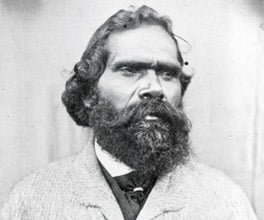Simon Wonga
Simon Wonga was born near Healesville in the 1820s. His father, Billibellary, was a respected leader and one of the ‘chiefs' of the Wurundjeri who met John Batman in 1835. When Wonga was in his mid-teens, he severely injured his foot while he was hunting and was cared for by William Thomas, Assistant Aboriginal Protector. Wonga soon befriended Thomas and his son, and even began calling Thomas marminarta, meaning ‘father'.
Wonga shared much of his understanding of traditional culture, language and beliefs with Thomas. He also learnt from Thomas how European society worked – information that would help him to develop into the skilled and respected negotiator he became in later life.
By 1851 Wonga had become ngurungaeta or headman of the Wurundjeri people. He used his knowledge and friends in the European community to support his people when they were treated unfairly:
[Wonga] made a contract with a publican in Richmond for the cutting for bark for the first shanty public-house on Anderson's Creek Diggings; the man did not pay him in full [...] The blacks came to me; I went to the employer and threatened to issue a summons; the publican then paid the money.
– William Thomas
Byrt, P 2005, 'Simon Wonga, Aboriginal leader', Victorian History Journal, Vol. 76, No. 1 April.
Not only did missionaries and Aboriginal protectors often defend Indigenous people's right to fair treatment, they also recorded the words and actions of people like Simon Wonga in documents we can read today.
Wonga was also one of the first Indigenous leaders to try and regain the land settlers had taken. In 1859, Wonga took a small group of Taungurong men from the Goulburn River to see William Thomas, acting as their interpreter and mediator. In a letter to Redmond Barry, Thomas quotes Wonga:
I bring my friends Goulburn Blacks, they want a block of land in their country where they may sit down plant corn potatoes etc etc, and work like white man.
– Simon Wonga
Byrt, P 2005, 'Simon Wonga, Aboriginal leader', Victorian History Journal, Vol. 76, No. 1 April.
After this meeting, a deputation was sent to the Commissioner of the Land and Survey Office where they met with officials and secured a portion of land for the Taungurong. A precedent had been set, and in 1860, Wonga returned to Thomas to ask for a piece of land for his own Wurundjeri people. The land he asked for later became the Coranderrk Aboriginal Mission. Wonga died there in 1875.











